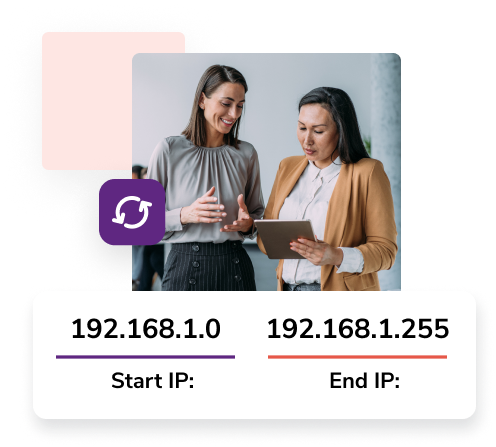Convert IP Range to CIDR
Use the free IP ranger to CIDR converter to quickly convert your IP address range to CIDR notation blocks.
Use the free converter ➜
Convert IP Address Range to CIDR Notation


How to use the IP range to CIDR converter
To use the CIDR notation converter:
- Enter the starting IP address in your list (e.g., 10.0.0)
- Enter the end IP address (e.g., 10.0.0.29)
Your IP address range ascends numerically. Double-check that your start and IP consist of the first and last numbers in the given range.
Then, click submit to receive your CIDR blocks.

Benefits of converting IP range to CIDR
Eliminate class-based inefficiencies
To better understand the benefits of CIDR, know the two types of IP addressing:
The assignment of IP addresses is classful when using IP ranges to set up things like mail servers or network security tools. This process results in efficiencies and wastage, as administrators must select a fixed class. The necessary IPv4 addresses are routed appropriately, while all others in the class are no longer available for use.
CIDR notation improves efficiency by categorizing IP addresses and determining assignments using the IP prefix rather than its class. This gives network administrators more flexibility when choosing IPv4 address assignments by basing them on the subnet mask instead of the entire class. You can then use CIDR blocks and split them up as needed.
Faster communication
By using CIDR notation, you minimize the number of IP addresses listed in a data packet. With fewer destinations listed, your data is able to travel from your server to the destination with fewer interruptions.
Cuts down on wasted IPv4 addresses
There is a fixed number of IPv4 addresses available. As the administrator, you must determine how to use your IPs efficiently to achieve the best performance and flexibility possible based on your business needs.

IP range to CIDR notation use cases
Setting up mail servers
Administrators and IT experts are often responsible for setting up and managing a company’s email servers for successful client communication.
Using the free tool to convert your IP range to CIDR can help minimize the amount of wasted IP and improve your IP management so that you can use more addresses in other scenarios.
Configuring internet service
Likewise, an IP range converter to CIDR will assist with internet setup and network management by better organizing IP ranges and creating more efficient pathways between the server and the end user.
Settings up cloud networks or VPCs for optimal security
CIDR notation is ideal for creating virtual private clouds (VPCs) for use within your company only. By creating a VPC, you have greater control over who can access the network and better oversight over the data shared within it.
Ensure clean and efficient email communication
Using the IP range to CIDR converter is a boon for your IP management. But when you’re done setting up your CIDR notation, you need to be sure other factors aren’t getting in the way of email delivery.
ZeroBounce specializes in 99% accurate email validationⓘA process that determines if an email address uses valid syntax, exists on a given domain, and is configured to receive incoming email messages and email deliverability tools, helping your email marketing get their messages to the inbox. Create your free account today to get
100 credits (no expiration)
Email validation - Detect 30+ email address types, including invalid, disposable, abuse, spam traps, and more
Catch-all Scoring - Score your catch-all emailsⓘAn email set up by a business to capture email messages sent to their name via an invalid address (e.g., j0hn@company.com instead of john@company.com). Catch-all inboxes receive a high volume of spam and may not be actively monitored by the owner. to find out which inboxes are being managed
Activity Data - Trace subscriber activity in the last 30, 60, 90, 180, 365, and 365+ days
Email server testingⓘA ZeroBounce service that analyzes an email server’s configuration by performing 100+ checks regarding header information, RFC documents, DNS records, email ports, and email authentication.
Header information
RFC-based testing
DNS checks
Email ports
DMARC analysis
100+ tests in total
Inbox placement testingⓘA process that allows users to analyze how an email performs with various email service providers before sending the campaign to a real audience. The test identifies errors with the header, body, and footer to help users remedy problems that prevent them from reaching the inbox.
Test emails against 20+ providers
Google, Outlook, Yahoo, Comcast, iCloud, and more
Spamhaus, Kaspersky, Symantec, Net-C, and more
Email FinderⓘA tool that allows users to look up an email address by using either a name, an email domain, or a combination of both data points.
Name-based queries
Domain-based queries
Blacklist MonitorⓘA service that actively observes your email domain and IP address while comparing it to known email blacklists and antispam services around the internet. If a blacklist flags either the domain or IP, the monitor will notify the user.
Domain/subdomain monitoring
IPv4 address monitoring
IPv6 address monitoring
API
Multiple API keys
60+ integrations
Documentation for all services
Manage from desktop or iOS
The No. 1 email validationⓘA process that determines if an email address uses valid syntax, exists on a given domain, and is configured to receive incoming email messages service for 400,000+ clients
FAQ
An IP range to CIDR converter rapidly converts a range of IP addresses into CIDR blocks for improved IP management based on the routing prefix or subnet mask.
Classless Inter-Domain Routing (CIDR) is a method for optimizing IP address usage and allocation by eliminating inefficiencies and IP waste caused by the traditional classful system.
An IP range is a series of consecutive IP addresses classified by the start and end IP addresses.
CIDR notation aids network administrators and IT professionals by allowing more efficient use of their IP addresses. CIDR uses a classless system, which allows administrators to use IP addresses by subnet mask as opposed to the more rigid class-based system of A, B, or C. The latter results in a large percentage of wasted IP addresses when the pool of available addresses is minimal. Using CIDR can also improve data transmission speeds by reducing the number of IP addresses that a packet must visit on the way to its destination.
The primary disadvantage of CIDR notation is the increased complexity involved when routing IP addresses compared to classful assignments.